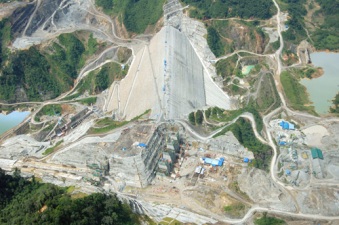KUALA LUMPUR: The RM7.3 billion
 in Sarawak, already condemned as a catastrophe for the environment and tribal people, is now battling suggestions it could become a giant white elephant.
in Sarawak, already condemned as a catastrophe for the environment and tribal people, is now battling suggestions it could become a giant white elephant.The dam, which will eventually submerge an area the size of Singapore, is finally nearing completion after suffering a series of setbacks and delays since its approval in 1993.
But at the last hurdle the project has stumbled again, with delays in winning the state government’s permission to begin the flooding process and no deal yet on purchasing its hefty 2,400 megawatt output.
With ambitious plans for an undersea cable to feed the Bakun’s electricity to the Malaysian peninsula now abandoned, the Sarawak government is the only feasible buyer — leaving it with a very strong hand.
Negotiations with the dam developer Sarawak Hidro, a subsidiary of the national finance ministry, have reportedly been tough.
“It’s a case where the owner of the project is naming an asking price that is very different to what the buyer would want,” said Wong Chew Hann, an analyst at Malaysia’s top bank Maybank.
“I understand there’s quite a huge mismatch,” she said. “I’m not sure what they’ve incorporated into the pricing, but the cost of the project has gone up so much since it was started.”
As well as the cost of construction, there is the expense of compensating tribal people for their forced relocation from ancestral lands, and suppliers affected by the long delays.
“So the question is, are you going to incorporate all the compensation costs in the tariff price?” said Wong.
Bargaining chip
With the indigenous people from the Bakun catchment area long since resettled and its valuable timber resources long since felled, the dam has been ready to be flooded since April.
The state government had delayed permission, saying it was still evaluating river levels and the impact on boat transport.
A Sarawak minister reportedly said last week that the necessary permit has been granted, denying both that it had been used as a bargaining chip to lower the tariff and that Sarawak was facing an energy glut.
Sarawak Hidro managing director Zulkiflie Osman played down suggestions that he has been held to ransom by the state government.
“Both parties are working together and want it to be settled amicably, with a tariff acceptable to both parties,” he said, adding that he expected to strike a tariff deal before December.
The next of Sarawak’s mega-dams, the Murum, which is being developed by the state government, is due to come online in 2013 but Osman said he was convinced the state authorities will not bypass Bakun in favour of its own project.
 Alongside the power purchase negotiations, the federal government is also said to be discussing selling the entire Bakun facility to the state government, but pricing and finance problems have emerged.
Alongside the power purchase negotiations, the federal government is also said to be discussing selling the entire Bakun facility to the state government, but pricing and finance problems have emerged.The federal government was reportedly seeking RM8 billion while the state government offer was just RM6 billion.
Fierce criticism
The Bakun’s output far exceeds existing energy needs in Sarawak, a relatively undeveloped state, and is mostly destined for industrial users such as aluminium smelters, but these are still on the drawing board.
“The main problem is that currently there is no demand for such a big capacity yet, and in order for Sarawak Energy to purchase the dam they would need adequate funding,” said an analyst with a major research house.
“The banks would ask for some kind of feasibility study, and as there is no real demand yet this project risks becoming a white elephant,” said the analyst, who declined to be named.
Transparency International has labelled Bakun a “monument of corruption” in Sarawak, which has been ruled for three decades by the formidable Chief Minister Taib Mahmud.
There has also been fierce criticism over the botched relocation of 15,000 indigenous people, who have made an unhappy transition to life in drab resettlement areas.
Baru Bian, chairman of the Sarawak PKR, said the Bakun project was designed purely to profit cronies, and not planned in the public interest.
“The dam is a waste of public funds, it’s not necessary, and what is paramount is that it is disturbing and disrupting the lives of the natives and the environment — the trees and the forests.”
- AFP













Tiada ulasan:
Catat Ulasan